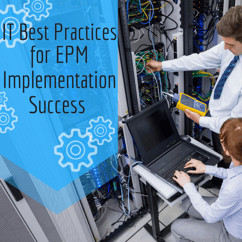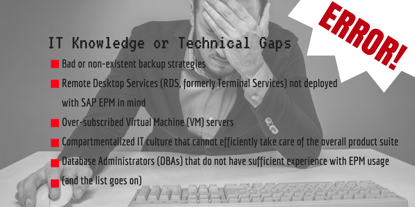If you follow best practices for SAP implementation and use, whether it be BPC, Disclosure Management, ECC,
HANA, ABAP, or many others, you will be successful in quantifying the benefits from the suite of products you choose. Our perspective is that there are no inherently “bad” SAP products, just poor implementation that can make your product use more stressful than it needs to be.
Column5 is often called upon to fix challenged implementations. The underlying cause of difficulties typically sprouts from avoiding best practices, regardless of the reason. When we find these challenges, we prescribe a remediation plan to correct the issues and get the solution back on track, quite rapidly in most cases.
sprouts from avoiding best practices, regardless of the reason. When we find these challenges, we prescribe a remediation plan to correct the issues and get the solution back on track, quite rapidly in most cases.
But another stumbling block to a successful implementation are the omnipresent, yet often underappreciated
stack of hardware (storage, networking, servers) and operating system. Shouldn’t customers be just as concerned with best practices for the technical building blocks of the platform supporting their SAP systems? The answer, of course, is a resounding:
YES!
This is obviously not a surprising answer, but you would be shocked at what the Column 5 implementation team encounters in real life.
A typical example goes something like this:
A finance team purchases SAP software and begins implementation; hopefully, along with a consulting partner, such as Column5, that honors best practices). The finance department’s IT team and/or infrastructure may not be prepared to fully support the implementation and have the resources to do what it takes to make this process successful.They might know the basics of individual components of the technology stack (hardware, networking, operating systems, databases, etc.). But, as to supporting the complex challenges and usage profiles that an EPM suite of products on that stack would require, they may be very unsuccessful.
Examples include:
- Bad or non-existent backup strategies
- Remote Desktop Services (RDS, formerly Terminal Services) not deployed with SAP EPM in mind
- Over-subscribed Virtual Machine (VM) servers
- Compartmentalized IT culture that cannot efficiently take care of the overall product suite
- Database Administrators (DBAs) that do not have sufficient experience with EPM usage
- (and the list goes on)
These significant knowledge and technical gaps can produce an unstable deployment stemming from inherent issues at the platform level. Such problems could wreak havoc at the worst time when the system is called upon to complete a critical cycle. Of course, major problems with a system’s usability are obvious. But even relatively minor issues with a poorly tuned solution will dilute the actual value of an otherwise well delivered product suite.
 Column5 has seen these best practices void on the technical side, and we recommend not to take any chances with an EPM platform’s stability. As an organization whose success rides on our ability to deliver customer satisfaction consistently, we have made investments in building the best team with the right skills to fix these issues for our customers. We offer a number of ways to get to stable and user satisfying condition:
Column5 has seen these best practices void on the technical side, and we recommend not to take any chances with an EPM platform’s stability. As an organization whose success rides on our ability to deliver customer satisfaction consistently, we have made investments in building the best team with the right skills to fix these issues for our customers. We offer a number of ways to get to stable and user satisfying condition:
- Technical Administration Training Courses: During implementation we will assist in bringing your IT team up to speed with training courses and hands-on training.
- Customized SAP-friendly Infrastructure: We will diagnosis, design, and follow through with the implementation of infrastructure with SAP EPM in mind for the servers, Active Directory, RDS, SQL Server installation / maintenance, and other IT-related services that directly affect the overall EPM suite.
- Managed Services: We will dedicate a number of hours each month to maintain customers’ EPM systems on-site.
- Hosting Options: We will host a customer’s entire EPM implementation on 99.9%+ uptime. We do this by using the robust infrastructure delivered by market leader Amazon Web Services (AWS) which allows us to take responsibility for all IT and product maintenance processes.
Again, there are no “bad EPM products”, just bad implementations/lack of best practices from both the product specific implementation perspective and the underlying IT stack. Column5 can help with all of this to ensure your EPM program success.
For more information on EPM implementation or performance along with other easy to use videos, visit our comprehensive webcast library:
Related Articles You May Enjoy:
SAP BPC Performance - Best Practices
Does BPC performance Depend on the Technology Stack?
5 Things You Can Do to Get the Best Performance from Your BPC MS 10/10.1 Server Environment, Part 1
5 Things You Can Do to Get the Best Performance from Your BPC MS 10/10.1 Server Environment, Part 2
 Author Bio:
Author Bio:
Tony DeStefanis has been the IT Systems Manager for Column5 Consulting for going on 3 years. He has extensive experience providing support for SAP EPM 10 MPC MS, SAP BPC v5.1, 7.0MS, and v5 .5MS. He has also had almost 5 years experience as a Senior Technical Consultant and IT for Column5.
Tony DeStefanis, IT Systems Manager, US Team











